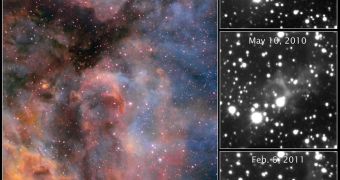About 174 years ago, one of the largest stars in the Milky Way, called Eta Carinae, underwent something called the Great Eruption. This was a huge explosion that made it the second-brightest star in the sky for about a decade, and which researchers are now finding was colder than first calculated.
This is a very intriguing finding, since it forces astronomers to come up with a new mechanism to explain why the star blew up in the first place. What is certain it that the object became extremely luminous all those years ago, even though it's located about 7,500 light-years from Earth.
What is even more interesting is that the star dimmed significantly after a 10-year period of peak luminosity. By 1848, it was less bright than many other objects in the night sky. Currently, it is not even in the top 100 most luminous stars.
According to the lead author of the new investigation on Eta Carinae, Armin Rest, the object is one of the most studied in the entire galaxy. The expert holds an appointment as an astrophysicist at the Space Telescope Science Institute (STScI) in Baltimore, Maryland.
One of the most important things to remember about this particular object is that it's a luminous blue variable (LBV) star, meaning that it undergoes periodic episodes of excessive brightness and dimness.
Investigators say that this cycle occurs because LBV stars constantly accumulate mass, even if it makes them unstable. Eventually, that extra weight makes them swell – therefore appear brighter – until an explosion removes the excess material.
It is believed that, during the Great Eruption, Eta Carinae shed the equivalent of 20 solar masses of matter from its surface. Before the event, it tipped the scales at 140 solar masses. What was interesting for experts was finding that the event took place at just 8,540 degrees Fahrenheit (4,725 ºC)
“This star's Giant Eruption has been considered a prototype for all supernova imposters (sic!) in external galaxies. But this research indicates that it is actually a rather unique event,” says Princeton University investigator and study coauthor Jose Prieto.
“With Eta Carinae, we are dealing with a really extreme phenomenon, which drags us into unexplored territory as far as theory is concerned,” Rest adds, quoted by Space.
“We do have some ideas, but these are really just ideas and have not been very well-developed, so we don't yet have clear predictions for the observed phenomena we expect to see,” he concludes. The expert and his team published their study in the February 16 issue of the top scientific journal Nature.

 14 DAY TRIAL //
14 DAY TRIAL //